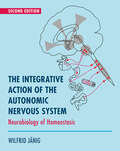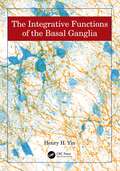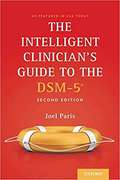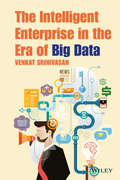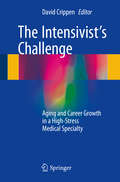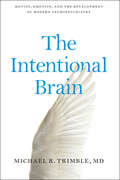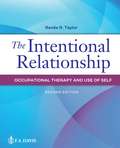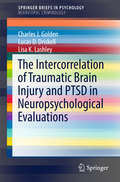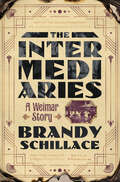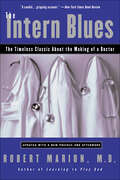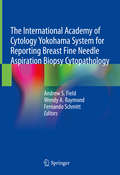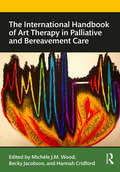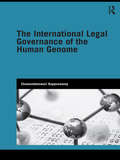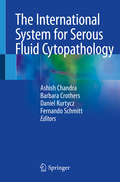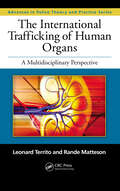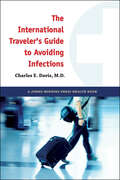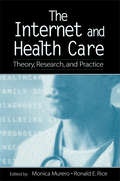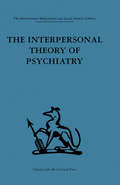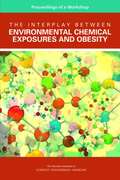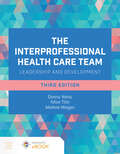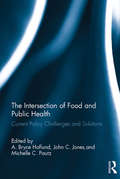- Table View
- List View
The Integrative Action of the Autonomic Nervous System: Neurobiology of Homeostasis
by Wilfrid JänigAlmost all bodily functions are dependent on activity of the autonomic nervous system – from the cardiovascular system, the gastrointestinal tract, the evacuative and sexual organs, to the regulation of temperature, metabolism and tissue defence. Balanced functioning of each aspect of this system is an important basis of our life and well-being. In this long-awaited second edition, the author, a leading figure in this field, provides an up-to-date and detailed description of the cellular and integrative organization of the autonomic nervous system, covering both peripheral and central aspects. The book exposes modern neurobiological concepts that allow us to understand why this system normally runs so smoothly and why its deterioration has such disastrous consequences. This broad overview will appeal to researchers and advanced undergraduate students of the various biological and medical sciences studying how the autonomic nervous system works and to clinicians and physical therapists whose practice involves systems dependent on autonomic functions.
The Integrative Functions of The Basal Ganglia
by Henry YinThis volume is the first comprehensive and single-authored book on the functions of the basal ganglia. The goal is to provide a new synthesis of diverse areas of research on the basal ganglia, from cellular mechanisms of synaptic transmission and plasticity to neural circuit mechanisms underlying behavior. A global theory of basal ganglia function incorporating research from the last 40 years is presented. I hope to explain for the first time how the basal ganglia generate behavior, how they contribute to learning and memory, and how impairments in basal ganglia function can lead to neurological and psychiatric disorders. Features The only single-authored book on the basal ganglia with coverage of the latest literature. Spans multiple levels of analysis, from cellular physiology to behavior. Includes coverage of clinical symptoms, encompassing neuropsychology, movement disorders, and psychiatric disorders. Discusses the role of the basal ganglia in learning and memory.
The Intelligent Clinician's Guide to the DSM-5
by Joel ParisThe Intelligent Clinician's Guide to the DSM-5 is the second edition of the widely-read book first published in 2013. This second edition is thoroughly revised, and has several new chapters describing the response to the publication of the new manual, as well as suggestions on its use in clinical practice. <P><P> The Intelligent Clinician's Guide to the DSM-5, Second Edition reviews the history of diagnosis in psychiatry, emphasizing the limitations for classification of our current lack of knowledge of the causes of most mental disorders. It emphasizes that, in the absence of biomarkers, current categories can only be considered provisional. It takes a critical look at schema for spectra and dimensionalisation of diagnosis, examines the borders between normality and psychopathology, and discusses the problem of clinical utility. The book has chapters on all the major diagnoses in psychiatry, in which the main problems of diagnosis are addressed, and in which all changes in DSM-5 are described.
The Intelligent Enterprise in the Era of Big Data
by Venkat SrinivasanAn innovative guide to the organization and function of enterprises in the technological age In the era of big data and automation, this book presents a cutting-edge approach in how enterprises should organize and function. Striking a practical balance between theory and practice, The Intelligent Enterprise in the Era of Big Data presents an enterprise architecture that embodies the power of the emerging technology environment. Beginning with an introduction to the key challenges that enterprises face, the book systematically outlines a modern enterprise architecture through a detailed discussion of the inseparable elements of such an architecture: efficiency, flexibility, and intelligence. This architecture enables rapid responses to market needs by facilitating intelligent, flexible automation of enterprise business processes and sensing important developments in internal and external environments in near real time. Illustrating all of these elements in an integrated fashion, The Intelligent Enterprise in the Era of Big Data also features: A detailed discussion on issues of time-to-market and flexibility with respect to enterprise application technology Novel analyses illustrated through extensive real-world case studies to help readers better understand the applicability of the architecture and concepts Practical approaches for designing and building intelligent enterprises An appendix that presents various approaches to text analysis with real-world business implications The Intelligent Enterprise in the Era of Big Data is an appropriate reference for business executives, information technology professionals, data scientists, and management consultants.
The Intensivist's Challenge
by David CrippenThis book brings together personal narratives from critical care medicine specialists around the world. Most of these physicians started in critical care at or before the exponential increase in technological modalities to reverse or sustain organ function, have seen patient care both ways, and have worked as many as 30 years or more at the bedside. The narratives are organized around such themes as : how and why these physicians entered the discipline of critical care; what was critical care like in the beginning; how they have experienced the flood of innovations in critical care; why they decided to retire (or not); and what their retirement options have been (or not). Composed by influential critical care medicine specialists, The Intensivist's Challenge: Aging and Career Growth in a High-Stress Medical Specialty is a valuable resource bringing together a discussion of the nature and problems of aging as they apply to physicians in a high-stress occupation, while assessing the value of clinical experience at the bedside in a world increasingly full of soulless technology.
The Intentional Brain: Motion, Emotion, And The Development Of Modern Neuropsychiatry
by Michael R. Trimble“A tour de force: an assessment of the ‘culture’ of mind–brain relations beginning with the ancients and ending in the present.” —Edward Shorter, PhD, National Book Award finalist and author of A History of PsychiatryNeuropsychiatry has a distinguished history, yet its ideals and principles fell out of fashion in the early twentieth century as neurology and psychiatry diverged into separate disciplines. Later, neuropsychiatry reemerged as the two disciplines moved closer again, accelerated by advances in neuroanatomy, neurochemistry, and drugs that alter the functioning of the central nervous system. But as neuropsychiatrist Michael R. Trimble explains in The Intentional Brain, the new neuropsychiatry has its own identity and is more than simply a borderland between two disparate clinical disciplines.Looking at neuropsychiatry in the context of major cultural and artistic achievements, Trimble explores changing views of the human brain and its relation to behavior and cognition over 2,500 years of Western civilization. Beginning with the early Greek physicians and moving through the Middle Ages, Enlightenment, Romantic era, World Wars, and present day, he explores understandings about the brain’s integral role in determining movement, motivation, and mood. Persuasively arguing that storytelling forms the backbone of human culture and individuality, Trimble describes the dawn and development of artistic creativity and traces the conflicts between differing philosophical views of our world and our position in it.A sweeping history of the branch of medicine concerned with both psychic and organic aspects of mental disorder, the book reveals what scientists have learned about movement and emotion by studying people with such diseases as epilepsy, syphilis, hysteria, psychosis, movement disorders, and melancholia. The Intentional Brain is a marvelous and interdisciplinary look at the clinical interface between the mind and the brain.
The Intentional Brain: Motion, Emotion, and the Development of Modern Neuropsychiatry
by Michael R. TrimbleA magnificent examination of the clinical interface between the mind and the brain.Neuropsychiatry has a distinguished history, yet its ideals and principles fell out of fashion in the early twentieth century as neurology and psychiatry diverged into separate disciplines. Later, neuropsychiatry reemerged as the two disciplines moved closer again, accelerated by advances in neuroanatomy, neurochemistry, and drugs that alter the functioning of the central nervous system. But as neuropsychiatrist Michael R. Trimble explains in The Intentional Brain, the new neuropsychiatry has its own identity and is more than simply a borderland between two disparate clinical disciplines.Looking at neuropsychiatry in the context of major cultural and artistic achievements, Trimble explores changing views of the human brain and its relation to behavior and cognition over 2,500 years of Western civilization. Beginning with the early Greek physicians and moving through the Middle Ages, the Enlightenment, the romantic era, the World Wars, and up to the present day, he explores understandings about the brain’s integral role in determining movement, motivation, and mood. Persuasively arguing that storytelling forms the backbone of human culture and individuality, Trimble describes the dawn and development of artistic creativity and traces the conflicts between differing philosophical views of our world and our position in it.A sweeping history of the branch of medicine concerned with both psychic and organic aspects of mental disorder, the book reveals what scientists have learned about movement and emotion by studying people with such diseases as epilepsy, syphilis, hysteria, psychosis, movement disorders, and melancholia. The Intentional Brain is a marvelous and interdisciplinary look at the clinical interface between the mind and the brain.
The Intentional Relationship: Occupational Therapy And Use Of Self
by Renee R. TaylorThis groundbreaking book addresses a critical aspect of the occupational therapy practice—the art and science of building effective therapeutic relationships with clients. A distinguished clinician, scientist, and educator, Renée Taylor, PhD, has defined a conceptual practice model, the Intentional Relationship Model, to identify how the client and the therapist each contribute to the unique interpersonal dynamic that becomes the therapeutic relationship. She emphasizes how therapists must act deliberately, thoughtfully, and with vigilant anticipation of the challenges and breakthroughs that have the potential to influence the course of the relationship.
The Intercorrelation of Traumatic Brain Injury and PTSD in Neuropsychological Evaluations
by Charles J. Golden Lucas D. Driskell Lisa K. LashleyThis concise reference clarifies the gray areas between traumatic brain injury and PTSD while providing an empirically sound framework for neuropsychological evaluation and differential diagnosis. Its extended research review summarizes findings on key topics including the neuroanatomy of brain injury, test battery design and selection, and the salience of accurate diagnosis to ensuring appropriate specialized treatment. The authors offer the possibility of combined diagnosis as well as injuries that may fall through the diagnostic cracks, and consider possible relationships between TBI, PTSD, and the dementias, including Alzheimer's disease. This knowledge base and the practical guidelines it informs are presented so that readers can better: #65533; Understand the clinical distinctions between TBI and PTSD, and among forms of TBI. #65533; Recognize cognitive, behavioral, emotional, and social components of the disorders. #65533; Identify skill areas for neuropsychological evaluation of patients. #65533; Select appropriate instruments for individualized assessment. #65533; Address test administration and interpretation concerns. #65533; Make an accurate differential diagnosis between PTSD and TBI. With its sharp focus on the nuances of trauma and recovery, The Intercorrelation of Traumatic Brain Injury and PTSD in Neuropsychological Evaluations will find a wide, interested audience among psychologists, neuropsychologists, neurologists, psychiatrists, social workers, mental health counselors, undergraduate and graduate level students, and researchers. In addition, this text may be useful for those interested in psychology and neurology.
The Intermediaries: A Weimar Story
by Brandy SchillaceThe fascinating history of a daring team of sexologists who built the first trans clinic in the shadow of the Third Reich. Set in interwar Germany, The Intermediaries tells the forgotten story of the Institute for Sexual Science, the world’s first center for homosexual and transgender rights. Headed by a gay Jewish man, Dr. Magnus Hirschfeld, the institute aided in the first gender-affirming surgeries and hormone treatments, acting as a rebellious base of operations in the face of rising prejudice, nationalism, and Nazi propaganda. An expert in medical history, Brandy Schillace tells the story of the Institute through the eyes of Dora Richter, an Institute patient whom we follow in her quest to transition and live as a woman. While the colorful but ultimately tragic arc of Weimar Berlin is well documented, The Intermediaries is the first book to assert the inseparable, interdependent relationship of sex science to both the queer rights movement and the permissive Weimar culture, tracking how political factions perverted that same science to suit their own ends. This riveting book brings together forgotten scientific and surgical discoveries (including previously untranslated archival material from Berlin) with the politics and social history that galvanized the first stirrings of the trans rights movement. Through its unforgettable characters and immersive, urgent storytelling, The Intermediaries charts the relationships between nascent sexual science, queer civil rights, and the fight against fascism. It tells riveting stories of LGBTQ pioneers—a surprising, long-suppressed history—and offers a cautionary tale in the face of today’s oppressive anti-trans legislation.
The Intern Blues: The Timeless Classic About the Making of a Doctor
by Robert MarionThe classic “gripping account” of three young doctors in training at a New York City hospital, updated with a new preface and afterword (The New York Times Book Review).While supervising a small group of interns at a major New York medical center, Dr. Robert Marion asked three of them to keep a careful diary over the course of a year. Andy, Mark, and Amy vividly describe their real-life lessons in treating very sick children; confronting child abuse and the awful human impact of the AIDS epidemic; skirting the indifference of the hospital bureaucracy; and overcoming their own fears, insecurities, and constant fatigue. Their stories are harrowing and often funny; their personal triumph is unforgettable.This updated edition of The Intern Blues includes a new preface from the author discussing the status of medical training in America today and a new afterword updating the reader on the lives of the three young interns who first shared their stories with readers more than a decade ago.“Thought-provoking, informative.” —Publishers Weekly‘The diary format effectively dramatizes the often-agonizing decisions and compromises that are made in the face of sleepless nights and inexperience . . . an important book for anyone contemplating the long, arduous task of becoming a doctor.” —Library Journal
The International Academy of Cytology Yokohama System for Reporting Breast Fine Needle Aspiration Biopsy Cytopathology: Special Topic Issue: Acta Cytologica 2019, Vol. 63, No. 4
by Fernando Schmitt Andrew S. Field Wendy A. RaymondThis text describes a system of reporting breast fine needle aspiration biopsy that uses five clearly defined categories, each described by a specific term and each with a specific risk of malignancy. The five categories are insufficient/inadequate, benign, atypical, suspicious of malignancy and malignant. Each category has a risk of malignancy and is linked to management recommendations, which include several options because it is recognized that diagnostic infrastructure, such as the availability of core needle biopsy and ultrasound guidance, vary between developed and low and middle income countries. This text includes key diagnostic cytological criteria for each of the many lesions and tumors found in the breast. The cytopathology of specific lesions is illustrated with high quality photomicrographs with clear figure descriptions. Chapters also discuss current and potential future ancillary tests, liquid based cytology, nipple cytology and management. An additional chapter provides an overview of an approach to the diagnosis of direct smears of breast fine needle aspiration biopsies.The International Academy of Cytology Yokohama System for Reporting Breast Fine Needle Aspiration Biopsy Cytopathology provides a clear logical approach to the diagnosis and categorization of breast lesions by FNAB cytology, and aims to facilitate communication with breast clinicians, further research into breast cytopathology and related molecular pathology, and improve patient care.
The International Handbook of Art Therapy in Palliative and Bereavement Care (Routledge International Handbooks)
by Hannah Cridford Michèle J.M. Wood Becky JacobsonThe International Handbook of Art Therapy in Palliative and Bereavement Care offers a multicultural and international perspective on how art therapy can be of help to individuals, groups, families, communities, and nations facing death and dying as well as grief and loss. Over 50 art therapists from around the world write about the transforming power of art therapy in the lives of those facing terminal illness, dementia, loss, and grief. They offer practical descriptions and techniques for working with adults and children to guide professionals, including those new to using art therapy and creative approaches in end-of-life care services. This international handbook is essential reading for arts therapists, social workers, medical personnel, faith leaders, and psychologists interested in a collaborative and accessible approach to working with patients and families affected by loss.
The International Legal Governance of the Human Genome (Genetics and Society)
by Chamundeeswari KuppuswamyThe human genome is a well known symbol of scientific and technological progress in the twenty-first century. However, concerns about the exacerbation of inequalities between the rich and the poor, the developing and the developed states, the healthy and the unhealthy are causing problems for the progress of scientific research. The international community is moving towards a human rights approach in addressing these concerns. Such an approach will be piecemeal and ineffective so long as fundamental issues about economic, social and cultural rights, the so-called second generation of human rights, are not addressed. This book argues that, in order to be able to meaningfully apply a human rights framework to the governance of the human genome, the international human rights framework should be based on a unified theory of human rights where the distinction between positive and negative rights is set aside. The book constructs a common heritage concept with the right to development at its core and explores the content of the right to development through rational human rights theory. It is argued that the notion of property rights in the human genome should be placed within the context of protecting human rights, including the right to development. The concept of common heritage of humanity, contrary to the widely held belief that it is in opposition to patenting of gene sequences, supports human rights-based conceptions of property rights. This book fills a gap in the literature on international legal governance of the human genome will provide an essential reference point for research into the right to development, development issues in bioethics, the role of international institutions in law making and research governance.
The International Migration of Health Workers
by Rebecca S. ShahExperts from ethicists and political philosophers to clinicians and trade unionists seek answers to a number of key ethical questions to further a deeper understanding of the ethics of health worker migration.
The International System for Serous Fluid Cytopathology
by Fernando Schmitt Ashish Chandra Barbara Crothers Daniel KurtyczThis book is the culmination of an international effort to bring consistency and diagnostic efficiency to effusion cytology for the sake of patient care. The authors recognize special challenges in serous fluid cytopathology, such as reporting the presence of Mullerian epithelium in peritoneal fluids. What is an appropriate serous fluid volume to ensure adequacy? How should mesothelial proliferations be reported and is it appropriate to make an interpretation of malignant mesothelioma? How specific should a report be regarding the origin and subtyping of tumors found in serous fluids? What are the appropriate quality monitors for this specimen type? Special chapters on considerations for peritoneal washings, cytopreparatory techniques, mesothelioma and quality management are included to address these issues. The text contains literature reviews that elucidate existing evidence in support of current practices and recommendations. Expert opinions on where evidence was lacking, the most common practices were adopted by consensus, and where there was no commonality, are employed. Written by experts in the field, The International System for Serous Fluid Cytopathology serves as a collaborative effort between the International Academy of Cytology and the American Society for Cytopathology and calls upon participation of the international cytopathology and oncology communities to contribute to the development of a truly international system for reporting serous fluid cytology
The International Trafficking of Human Organs: A Multidisciplinary Perspective (Advances in Police Theory and Practice)
by Leonard Territo Rande MattesonInternational illicit trade in human organs is on the increase, fueled by growing demand and unscrupulous traffickers. In order to truly understand the problem of organ trafficking, an analysis should take into account the various perspectives that come into play in this multifaceted issue. With contributions from international scholars and experts
The International Traveler's Guide to Avoiding Infections (A Johns Hopkins Press Health Book #1)
by Charles E. DavisThe last thing a world traveler wants is to get sick. To stay healthy, travelers need to protect themselves from viruses, bacteria, and parasites, including many they have seldom, if ever, encountered. With precise, simple explanations, this indispensable guide helps international travelers avoid common—and uncommon—infections wherever they go. Relating important medical findings, Dr. Charles E. Davis provides the latest recommendations for healthy travel planning. He describes the precautions travelers can take to prevent infection, including• pre-trip travel clinic visits• essential immunizations and medications• travel insurance and medical kits• safe food and water practices• personal protection measures• post-trip checkupsThe International Traveler's Guide to Avoiding Infections is organized by disease, with highly accessible discussions and detailed illustrations of all the major travelers' infections. Maps make it easy to see where infections are commonly acquired, and specific prevention strategies for each destination enhance travel planning. Tourists and professionals such as military personnel, journalists, aid workers, and businesspeople need the tools provided here to stay healthy during their trip and after they return home.
The Internet and Health Care: Theory, Research, and Practice (Routledge Communication Series)
by Ronald E. Rice Monica MureroThe Internet and Health Care: Theory, Research, and Practice presents an in-depth introduction to the field of health care and the Internet, from international and interdisciplinary perspectives. It combines expertise in the areas of the social sciences, medicine, policy, and systems analysis. With an international collection of contributors, it provides a current examination of key issues and research projects in the area. Methods and data used in the chapters include personal interviews, focus groups, observations, regional and national surveys, online transcript analysis, and much more. Sections in the book cover:*e-Health trends and theory; *searching, discussing, and evaluating online health information at the individual level of analysis; *discussing health information at the group or community level; and *implementing health information systems at the regional and social level. The Internet and Health Care will prove useful for university educators and students in the social, public health, and medical disciplines, including Internet researchers. It is also oriented to professionals in many disciplines who will appreciate an integrative theoretical, empirical, and critical analysis of the subject matter, including developers and providers of online health information.
The Internet and Health in Brazil: Challenges and Trends
by André Pereira Neto Matthew B. FlynnThe popularization of the Internet, due in larger part to the advent of multifunctional cell phones, poses new challenges for health professionals, patients, and caregivers as well as creates new possibilities for all of us. This comprehensive volume analyzes how this social phenomenon is transforming long-established healthcare practices and perceptions in a country with one of the highest numbers of Internet users: Brazil. After an opening text that analyzes the Internet and E-Health Care as a field of study, the book comprises six parts. The first part introduces the emergence and development of the internet in Brazil, its pioneering experience in internet governance, digital inclusion, and online citizen participation. The second part is dedicated to internet health audiences by analyzing the cases of patients, the young, and the elderly seeking and sharing health information online, especially in virtual communities. The third part is dedicated to the challenges that the expansion of the internet in healthcare poses to all of us, such as the evaluation of the quality of health information available online and the prevention of the risks involved with online sales, cyberbullying, and consumption of prescription medicines. The fourth presents some innovative e-learning experiences carried out with different groups in Brazil, while the fifth part analyses some practical applications involving the Internet and health, including studies on M-Health, the Internet of things, serious games and the use of new information and communication technologies in health promotion. The last chapter analyses the future of healthcare in the Internet Age. The authors establish a critical and creative debate with international scholarship on the subject. This book is written in a direct and comprehensible way for professionals, researchers, students of communication and health, as well as for stakeholders and others interested in better understanding the trends and the different challenges related to the social phenomenon of the internet in health.
The Interpersonal Theory of Psychiatry
by Harry Stack SullivanTavistock Press was established as a co-operative venture between the Tavistock Institute and Routledge & Kegan Paul (RKP) in the 1950s to produce a series of major contributions across the social sciences. This volume is part of a 2001 reissue of a selection of those important works which have since gone out of print, or are difficult to locate. Published by Routledge, 112 volumes in total are being brought together under the name The International Behavioural and Social Sciences Library: Classics from the Tavistock Press. Reproduced here in facsimile, this volume was originally published in 1955 and is available individually. The collection is also available in a number of themed mini-sets of between 5 and 13 volumes, or as a complete collection.
The Interplay Between Environmental Chemical Exposures and Obesity: Proceedings of a Workshop
by Engineering Medicine National Academies of SciencesIn March 2015, the National Academies of Sciences, Engineering, and Medicine held a workshop to explore the role that chemical exposures may play in the development of obesity. The obesity epidemic that has gripped the United States and much of the developed world for the past several decades has proved remarkably resistant to the various approaches tried by clinicians and public health officials to fight it. This raises the possibility that, in addition to the continued exploration of consumer understanding and behavior, new approaches that go beyond the standard focus on energy intake and expenditure may also be needed to combat the multifactorial problem of obesity. The speakers at the workshop discussed evidence from both studies with animal models and human epidemiological studies that exposure to environmental chemicals is linked both to weight gain and to glucose tolerance, insulin sensitivity, inflammation, and other aspects of the metabolic syndrome. In addition to conventional environmental chemical exposures, this workshop also included one panel to discuss the potential role of other exposures, including sugar, artificial sweeteners, and antibiotics, in aiding or causing obesity. The participants also examined possible biological pathways and mechanisms underlying the potential linkages. This publication summarizes the presentations and discussions from the workshop.
The Interprofessional Health Care Team: Leadership and Development
by Donna Weiss Felice Tilin Marlene J MorganThe Interprofessional Health Care Team: Leadership and Development, Third Edition is designed to help future health professionals realize their capacity for leadership and develop the knowledge, skills and attitudes that are requisite to becoming a positive agent of change and growth in themselves and others and the organizations within which they work. It describes possibilities and options, theories, exercises, rich references, and stimulating questions that will inspire both novices and experts to think differently about their roles and styles as leaders or members of a team. The authors provide many tools to empower readers and facilitate the fostering of productive teamwork. It is an inspiring book with easily operational principles. It is written for many audiences and to achieve many goals all centered on best practices to attain quality care, particularly during this time of reinventing and transforming health care.
The Intersection of Environmental Justice, Climate Change, Community, and the Ecology of Life
by Cathryne L. Schmitz Ande A. Nesmith Yolanda Machado-Escudero Shanondora Billiot Rachel A. Forbes Meredith C. Powers Nikita Buckhoy Lucy A. LawrenceThis book examines and encourages the increasing involvement of those in the social sciences, including social work, as well as everyday citizens, with environmental injustices that affect the natural ecology, community health, and physical and mental health of marginalized communities. The authors draw on their diverse experiences in research, practice, and education to suggest interdisciplinary strategies for addressing environmental justice, climate change, and ecological destruction on both a local and global scale. This insightful work presents models for action, practice, and education, including field learning, with examples of how programs and schools have integrated and infused environmental justice content across their curricula. Environmental and ecological impacts on local communities as well as the whole ecology of life are examined. Models for engaging civic dialogue, addressing structural oppression, and employing other interdisciplinary responses to environmental injustices are provided.Topics explored among the chapters include:Water, Air, and Land: The Foundation for Life, Food, and SocietyHuman Health and Well-Being in Times of Global Environmental Crisis Power and Politics: Protection, Rebuilding, and JusticePathways to Change: Community and Environmental TransformationDecolonizing Nature: The Potential of Nature to HealThe Intersection of Environmental Justice, Climate Change, Community, and the Ecology of Life equips readers to identify the impact of the global environmental crisis in their own communities. Emphasizing the need for immediate action on ecological, climate, and environmental justice issues, this forward-thinking book assists social science professionals, educators, researchers, and other concerned individuals with the knowledge needed for creating meaningful interdisciplinary responses in their communities as they take action within a rapidly changing context.
The Intersection of Food and Public Health: Current Policy Challenges and Solutions (Public Administration for Public Health)
by Michelle C. Pautz A. Bryce Hoflund John C. JonesPresently, ideas about food are in flux from a variety of sources. Examples of this evolution include recognizing the importance of food on health by public health and medical professionals; changing consumer desires around the production methods and components of their food; a greater focus on injustices within the national food system; evolving knowledge of how the food system impacts the environment; and, shifting economic and technological realities that underpin where and how food is produced, distributed and sold. These shifting ideas about food exist in contrast to the narrative of the highly functioning, industrialized, global food system that emerged in the second half of the 20th century. This edited volume fills a void by presenting a comprehensive and engaging coverage of the key issues at the intersection of public health, policy, and food. The Intersection of Food and Public Health is comprised of research that examines current problems in food studies and how various stakeholders are attempting to address problems in unique ways. The book will be of interest to undergraduate and graduate students in a variety of disciplines, including public administration, public policy, public health, economics, political science, nutrition, dietetics, and food studies.
